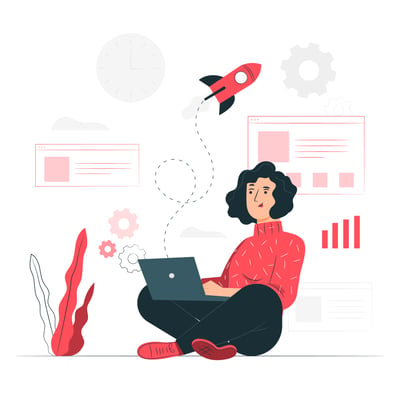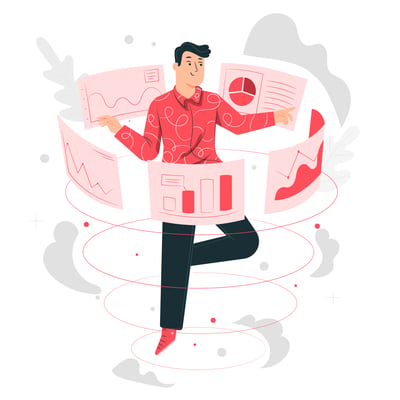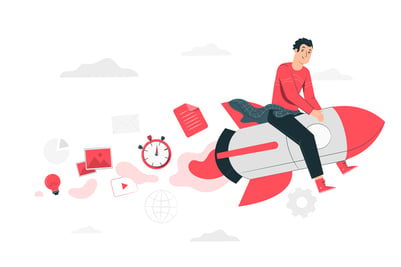Why so many customer portals fail and what to do about it
By Martino Corbelli, Marketing Director at POPX
Published on August 16, 2021

Why are customer portals such a touchy subject and cause of embarrassment for so many service providers? Why do so many Managed Service Providers (MSPs) frustrate customers with multiple portals to log into for different categories of service? And ultimately, why are so many customers being let down with poor levels of service that manifest in a user experience that simply has no place in today’s business environment?
If I had a pound coin for every customer portal that failed to deliver on expectations, I’d have enough money to fund an imaginary trip around the world, that will sadly have to be consigned to wishful thinking until post pandemic when the skies open up again. So, in the meantime, instead of packing my budgie smugglers, factor 50 and a multi-pack of Covid-19 tests, let’s take a look at some of the common factors that negatively impact service provider portal success and compromise their outcomes. In the interests of keeping positive, what I’ll also attempt to do is seamlessly, or at least not too cack-handedly, suggest ways of mitigating those issues.
Held back by legacy
New portal projects are intrinsically linked to digital transformation initiatives and are how MSPs surface the latest service automation successes to customers. They can be seen as part of the transformation effort and one of the final jigsaw puzzles that helps to piece everything together. However, transformation projects themselves are often fraught with risk, delays, budget overruns and after years of effort can simply run out of energy, or funding, leaving the portal project hanging.
Whilst portals are a crucial part of the transformation story they should be seen as their own important and separate initiative. They often crossover with transformation programs, because modernising operations without digitising the last mile by providing customers with slick self-service facilities reduces the impact and ROI of those investments. Only when the customer can see, touch and benefit directly from service automation, will the service provider see the full returns.
Unhelpful dependencies
By separating the customer portal from other transformations and viewing it as a standalone project, you break a dependency that has the potential to render it stillborn. Instead, put the portal first and allow the outcomes of any digital transformation to be implemented into the portal as and when those new processes come on-stream. In the meantime, don’t let legacy hold you back and whatever your past technology choices, find a way to integrate them into your portal, so you can give customers the transformation experience they seek now rather than later or possibly never.
There are some other more people-oriented aspects that impact this situation too. It’s not uncommon for the technical people that run internal IT systems and guard the data in them to see a particular initiative as a threat to their status or their future employment. This alone could provide insurmountable resistance to change. You will need them to collaborate and allow access to systems and data, so keeping all team members onside and engaged needs to be embedded in the leadership because you cannot implement meaningful change without them.
Fear of change
If you’re considering a new customer portal, it’s likely you are about to start or somewhere along a transformation journey. Any negativity surrounding your transformation initiatives can also impact your portal development efforts as many of the same people may be involved. Change management practices must be part of any transformation ensuring full transparency of information relating to what the initiative is, why it’s being done, detailing the intended outcomes and how all this will impact people personally. Helping team members to understand they are valued and an important part of both the journey and the destination, can avoid unnecessary trauma.
In fact, once you have automated many tasks and processes the future may look very different and will need a newly shaped operational team to underpin it. Invite those involved and affected to participate in what the new teams will look like through organisational design workshops. Leveraging their experience and knowledge will provide the best opportunity to get it right. Keeping people in the dark will put any transformation at risk and feed the rumour mill, as employees make up their own, potentially damaging, narrative around the proposed changes.
Too busy chasing tails
Unfortunately, the environment of many ICT service providers is not always conducive to promoting portal success. Most organisations will have some degree of internal politics, teams working in silos, and legacy IT systems that are critical but were never designed to talk to other systems. Multiply these issues by a factor of 100 and you get a typical mid-sized MSP. This is at the very core of why so many of them have multiple unconnected customer portals, all of them offering limited functionality and a less than satisfactory customer experience.
Then consider that many MSPs grow through acquisition and can be made up of many separate companies, often operating in walled gardens, vaguely cobbled together by a single brand. You can then see why any attempt to build a customer portal has the potential to become an expensive hiding to nothing. They are so frantically busy keeping the lights on and maintaining disparate systems in a desperate attempt to paper over cracks and keep customers happy, that they don’t have the time and space to fully think through and plan before launching into a portal project.
Living the service provider's nightmare
Service providers are being pushed, by both the market and their owners, to run before they can walk, because the need to differentiate with great service levels via a self-service portal is so great. Too many internal stakeholders, with too many agendas, a myriad of incompatible systems, a lack of real planning and only a vague understanding of what it takes to deliver success will cripple any well-intentioned effort.
Once the money and time have run out and the delivery has not materialised, any existing friction between departmental heads gets exacerbated and trust from the investor board in their executive team to deliver on a plan gets eroded. There is a great deal riding on getting this right and if that doesn’t happen the damage to personal and professional relationships can be significant, jeopardising the willingness of owners to sign-off other important projects and investments.
Now for the clumsy cack-handed interlude you were waiting for
As stated earlier, we’ll keep a balanced approach and neatly, or not, Segway into providing positive guidance that may assist in steering through the choppy waters of developing a fit-for-purpose customer portal. So let’s continue with some helpful tips to set you off in the right direction.
Start with why?
Ok, it’s a bit more than just “why” but asking why you need a portal in the first place is a good thing to do. Lots of soul searching and existential questions are probably best asked before starting a portal project than at the end, when things may not have turned out as you’d hoped. It’s always good to cover the key ones first, like:
- Why? - Why do we need a portal and what must it deliver?
- What? - What is it, and what difference will it make to the business?
- Who? - Who is it for, how will they interact with it and for what purposes?
- How? - How will it be funded, delivered, maintained and where are those skills?
Understanding what success looks like and mapping out what it will take to get there from a technical roadmap point of view, would set the right kind of expectations with all stakeholders. The answers to these, and no doubt many other questions, will help define what your portal needs to do, look like, deliver and will articulate a supporting business case. This will also help create a vision that will serve to keep everyone on track.

Create a shared vision
There needs to be a fully internalised vision for who the portal is for and what it is supposed to do for them. That vision must be shared by everyone involved and communicated to users so they can hold authors accountable. Transparency in all key aspects relating to services and their state, provisioning and billing is key and puts the customer in control of the relationship they have with you.
Self-service options take this to another level by giving customers the opportunity to manage their own services and get exactly what they want, exactly when they want it. The experience needs to be of a quality that makes it easy for them to interact and find what they need quickly. Automating bad practices and processes will simply cause more frustration and quickly turn them off. Take the opportunity to review all work streams, focusing on what the outcome needs to be and then working backwards from there to define the best process to serve that deliverable.
More than just a fancy website
Customer portals are being invested in and leveraged to differentiate service providers from their competitors powered by service automation. Those that do this well will reap significant benefits but those that fail or don’t even try are expected to get shunned by clients as they seek a more modern provider that can cater to their demands. A fully functioning, self-service customer portal, with everything under a single pane of glass, has become a strategic advantage too important to be ignored. One of the biggest issues that condemn portal projects to failure is not fully appreciating what a customer portal is.
There is a popular misconception that a customer portal is just a fancy website but that couldn’t be further from the truth. Anyone thinking web developers are the single and primary dependency will find the launching point for their project will be grossly off-kilter, ending in disaster. Unfortunately, that is a common misunderstanding. By now you are probably starting to conclude that portals are not easy to do and even harder to get right, and that is true. However, by focussing on what a customer portal really is and what’s needed to create one, you will significantly increase your chances of success.

Build or buy?
Just because something is hard to do doesn’t mean it isn’t achievable and worthwhile. It means the rewards are even higher and are there for the taking by anyone brave enough to commit to it. It’s too simplistic to state that not having the required skills in-house will condemn your project to failure and therefore the obvious conclusion is to outsource. Just as many outsourced portal projects have failed for many of the same reasons.
To say you need to tread carefully is clear. There will be trusted internal stakeholders who have some technical understanding of what’s needed but that doesn’t guarantee success either. Fundamentally, it is important to learn what it takes to deliver a customer portal and then seek out those skills, wherever they may be. What’s of paramount importance is to access the right set of capabilities from people that possess the required skills and have the demonstrable experience to deliver success.
Where the magic happens
Of course, you do need experienced web developers and UX skills to deliver a great customer portal but the real work to establish and feed the content for the presentation layer happens underneath that. This is what separates the good from the bad and where the majority of the efforts lie. Having the capability to integrate to all the disparate systems that must feed into the portal is one of the biggest and most important efforts. If you don’t have integration capabilities that can do this effectively and reliably then success will illude you at the first hurdle. Handling and maintaining those data flows is a constant and fundamental requirement.
Wherever you are on your transformation journey, without the ability to integrate and move data to where it can add value to your customers, they will ever fully benefit from all your hard work, and neither will you. In combination with the integration capability, is the need for a workflow engine that can orchestrate the tasks and processes as they flow seamlessly between the presentation layer and your back-end operations. This allows customers to get the full benefit of next level service automation. The combination of these two key capabilities, work to bring to life and enrich the presentation layer. In doing so, this in turn liberates new and exciting levels of customer engagement, delivering sales opportunities that would otherwise be impossible to achieve.
Not a one-hit wonder
Like any good technology solution, a customer portal needs ongoing development and nurturing. Just as the business landscape develops and different operational technologies are onboarded, the portal will need to reflect those changes. There may be a beginning to its creation but there is no defined end. Instead, what’s necessary is an ongoing development of continuous improvements and innovations that represent new and untapped opportunities. A customer portal is an organic entity, in that it will develop, change and improve over time.
There will never be a point in time where you down tools and say, ok that’s done, what’s next? A successful customer portal requires a dedicated team, budget and ongoing vision for development. It doesn’t matter whether some or all of those team members are internal, external, indeed a mixture of the two may be optimal. Without such a long-term approach, things can become stale very quickly, and before you know it your competitors are leapfrogging ahead.
Getting started
For something as important as a customer portal, that if done well can significantly improve customer loyalty and drive sales growth, it’s imperative to set the right conditions for success. There must be an executive sponsor who will ensure any internal barriers and politics can be cut through and overcome. Ideally, the CEO will assume this role, taking overall responsibility for the success or otherwise. The right people with the right skills and supporting resources must then be gathered and empowered to deliver under the CEO’s auspices.
Then, if necessary, seek out the right help from third-party sources to supplement internal skills with specialist knowledge and make up any shortfall in expertise. DO NOT wait for your portal initiative to be in distress and in need of recovery before looking for the right help. Get them involved from the start and view their support as your insurance policy to guard against failure. Cutting corners, and budgets, by trying to do everything in-house, or with the wrong partner, could be a false economy you can ill afford.
Customer portal top 10 checklist
- Define what a customer portal is in the context of your business and customers.
- Answer the critical questions, such as “who, what, why, how,” that will help articulate the business case.
- Create a vision for the portal to share with all staff and customers.
- Agree and state across the team what success looks like.
- Identify the capabilities required to deliver and where they can be accessed.
- Gather the team members responsible for implementing and maintaining the portal and guide them with constant alignment.
- Ensure there is an integration and workflow engine that the portal’s presentation layer can sit on top of.
- Use point 7 to help develop a supporting technology roadmap.
- Ensure the UX is of the highest quality, so customers find the portal easy to use and buy from.
- Set high standards for customer service and continuous innovation to drive future portal development.

